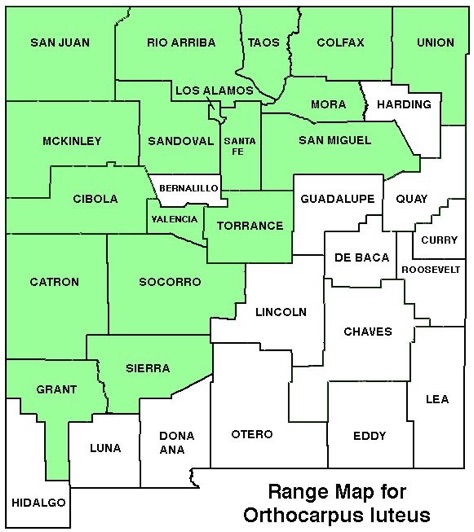WILDFLOWERS OF NEW MEXICO

Growing 4–16-inches tall with numerous erect, yellowish-green to purplish stems dense with glandular hairs, this plant is parasitic on roots of nearby plants. Note the stems terminate in leafy spikes of yellow, club-shaped flowers. Plants can form loose colonies in open areas, and are partially parasitic on roots of other plants.
FLOWERS: July–September. Dense, hairy spike with green, leaf-like bracts, tubular yellow flowers 3/8–5/8-inch long (10–15 mm), 2 lips of equal length, upper lip hood-like enclosing anthers and style, lower lip with a slight pouch.
LEAVES: Alternate. Lower stem leaves linear to lance-shaped, margins entire, tips pointed, upper leaves with 3 deep lobes; blades 1/2–1 3/8-inches long (15–35 mm), surfaces glandular-hairy.
HABITAT: Moist sandy, gravelly soils, meadows, riparian areas, roadsides; sagebrush scrub, pinyon-juniper, ponderosa, aspen forests.
ELEVATION: 6,000–9,900 feet.
RANGE: AZ, CO, NM, UT; Rocky Mountain states and westward.
SIMILAR SPECIES: The closely related Purple-white Owl-clover, O. purpureoalbus, in the western half of NM, has purple and white flowers. Yellow Paintbrush, Castilleja septentrionalis, in northern NM, has showy, yellow bracts.
NM COUNTIES: Widespread in NM mountains (absent from se plains) in mid- to high-elevation moist habitats: Catron, Cibola, Colfax, Grant, Los Alamos, McKinley, Mora, Rio Arriba, San Juan, San Miguel, Sandoval, Santa Fe, Sierra, Socorro, Taos, Torrance, Union, Valencia.









YELLOW OWL-CLOVER
ORTHOCARPUS LUTEUS
Broomrape Family, Orobanchaceae (formerly in Scrophulariaceae)
Annual herb; hemiparasitic









THE CONTENTS OF THIS WEBSITE ARE COPYRIGHTED AND CANNOT BE USED
WITHOUT PERMISSION OF GEORGE OXFORD MILLER




















































EMAIL ME







